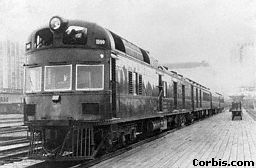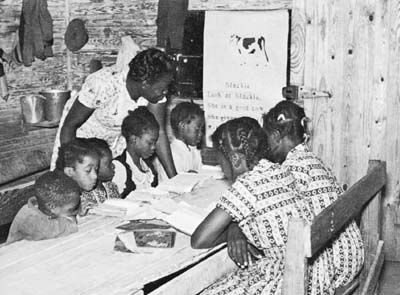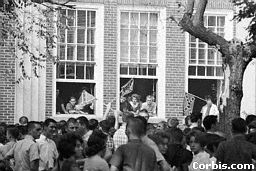Jim Crow Museum
1010 Campus Drive
Big Rapids, MI 49307
[email protected]
(231) 591-5873
How truly equal is "separate but equal"? How can true equality exist between two peoples who are racially segregated everywhere they go? Apparently, this was not an issue for the United States Supreme Court when it decided on the case of Plessy vs. Ferguson in 1896. The Court ruled in favor of separate areas for blacks and whites as long as they were equal, a decision which would prove to hold for almost 60 years until being overruled. This was a situation when the United States Supreme Court misused its power to interpret the Constitution in a way to benefit all peoples of the country. The ruling resulted in a major setback in the struggle for equality between races in the United States and set the stage for racial segregation within the South until the overruling in 1954. 1896 needs to be a constant reminder to the people of our country of the horrible damages done to society when the highest court of law in the land rules against justice and equality.
The case of Plessy vs. Ferguson was one of a combination of rulings passed by the
U.S. and state Supreme Courts after Reconstruction. Many of these decisions allowed
and even required Jim Crow segregation laws in Southern states. They returned to whites
the superiority over blacks that the 13th Amendment had taken away from them after
the Civil War. Plessy vs. Ferguson was the final step in erasing the policies put
in place during Reconstruction. The Reconstruction Era (1867-1877) was an atte mpt by the Union to put back together a war-torn South. Northerners were sent into
southern states to set up Reconstruction governments, which were completely in place
by 1870. The Reconstruction Era saw many positive changes in the lives of African
Americans: for example, the number of black children in school rose from 25,000 in
1860 to 149,581 in 1870 and the number of black voters rose from 0 in 1860 to 700,000
in 1867 (all men of course) . However, when Congress withdrew federal troops from
the Southern states in 1887, marking the end of Reconstruction, conditions deteriorated
quickly for blacks living there. While the 15th Amendment in 1870 had legally given
blacks the right to vote, grandfather clauses and poll taxes made it almost impossible
for them to exercise this right. The Ku Klux Klan was inciting race riots, and, starting
in 1882 and up until 1968, a total of over 4,700 blacks were lynched . Segregation
also took off in many Southern states, as whites searched for this lost feeling of
superiority. When blacks went to the courts to try to reclaim equality and justice,
they were harshly turned away. In 1878, the United States Supreme Court ruled that
segregation on common carriers (such as railway cars and buses) could not be prohibited
by state legislatures. In 1890, the Court took another step in ruling that Mississippi's
requiring segregation on common carriers was lawful. The Louisiana legislature also pushed
for segregation. It passed a bill in 1890 which said that "separate but equal" areas
for black and white passengers on trains was lawful and that violators could be fined
or jailed. This is where the case of Homer Plessy comes in. Plessy, a young shoemaker
who was one-eighth black and seven-eighths white, boarded a Louisiana state rail car
on June 7, 1892. Backed by two groups fighting racism, Comite des Citoyens and the
black newspaper, The Crusader, he sat down in the "White Only" rail car, and refused
to move when asked to do so. Plessy was immediately jailed. Homer Plessy and the groups
supporting him took their case to the local circuit court, judged by John Howard Ferguson,
the Louisiana Supreme Court, and finally to the United States Supreme Court. At the
highest level, the case was decided on May 18th, 1896, in favor of Judge Ferguson
and the state of Louisiana. By this time, the lasting damage had already been done.
The Supreme Court had given Southern states all the permission they needed to let
any remaining equality between the races fade away, to be replaced by the monstrous
Jim Crow laws standing in its way.
mpt by the Union to put back together a war-torn South. Northerners were sent into
southern states to set up Reconstruction governments, which were completely in place
by 1870. The Reconstruction Era saw many positive changes in the lives of African
Americans: for example, the number of black children in school rose from 25,000 in
1860 to 149,581 in 1870 and the number of black voters rose from 0 in 1860 to 700,000
in 1867 (all men of course) . However, when Congress withdrew federal troops from
the Southern states in 1887, marking the end of Reconstruction, conditions deteriorated
quickly for blacks living there. While the 15th Amendment in 1870 had legally given
blacks the right to vote, grandfather clauses and poll taxes made it almost impossible
for them to exercise this right. The Ku Klux Klan was inciting race riots, and, starting
in 1882 and up until 1968, a total of over 4,700 blacks were lynched . Segregation
also took off in many Southern states, as whites searched for this lost feeling of
superiority. When blacks went to the courts to try to reclaim equality and justice,
they were harshly turned away. In 1878, the United States Supreme Court ruled that
segregation on common carriers (such as railway cars and buses) could not be prohibited
by state legislatures. In 1890, the Court took another step in ruling that Mississippi's
requiring segregation on common carriers was lawful. The Louisiana legislature also pushed
for segregation. It passed a bill in 1890 which said that "separate but equal" areas
for black and white passengers on trains was lawful and that violators could be fined
or jailed. This is where the case of Homer Plessy comes in. Plessy, a young shoemaker
who was one-eighth black and seven-eighths white, boarded a Louisiana state rail car
on June 7, 1892. Backed by two groups fighting racism, Comite des Citoyens and the
black newspaper, The Crusader, he sat down in the "White Only" rail car, and refused
to move when asked to do so. Plessy was immediately jailed. Homer Plessy and the groups
supporting him took their case to the local circuit court, judged by John Howard Ferguson,
the Louisiana Supreme Court, and finally to the United States Supreme Court. At the
highest level, the case was decided on May 18th, 1896, in favor of Judge Ferguson
and the state of Louisiana. By this time, the lasting damage had already been done.
The Supreme Court had given Southern states all the permission they needed to let
any remaining equality between the races fade away, to be replaced by the monstrous
Jim Crow laws standing in its way.
Even though the Supreme Court had ruled in favor of these separate areas as long as
they were equal, it is evident that true equality was never an objective or goal within
the South. "Laws permitting, and even requiring (the separation of blacks and whites)
in places where they are liable to be brought into contact do not necessarily imply
the inferiority of either race to the other.......... The argument also assumes that
social prejudice may be overcome by legislation, and that equal rights cannot be secured
to the Negro except by an enforced commingling of the two races. We cannot accept
this proposition. If the two races are to meet on terms of social equality, it must
be the result of natural affinities, a mutual ap preciation of each others merits and a voluntary consent of individuals........."
(from the United States Supreme Court case of Plessy vs. Ferguson). But how possible
is it for two peoples to have a mutual appreciation of each other's merits if everywhere
they look around themselves they are told that they cannot ride on the same train
car, drink from the same fountain, sit on the same bench, or learn at the same school?
How can these peoples be separated in everything they do, everywhere they go, and
still be expected "to meet on terms of social equality"? Frederick Douglass didn't
think they could. In his 1872 article for The New National Era newspaper, he wrote,
"We want mixed schools.....because we want to do away with a system that exalts one
class and debases another..... We look to mixed schools to teach that worth and ability
are to be the criterion of manhood and not race and color."
preciation of each others merits and a voluntary consent of individuals........."
(from the United States Supreme Court case of Plessy vs. Ferguson). But how possible
is it for two peoples to have a mutual appreciation of each other's merits if everywhere
they look around themselves they are told that they cannot ride on the same train
car, drink from the same fountain, sit on the same bench, or learn at the same school?
How can these peoples be separated in everything they do, everywhere they go, and
still be expected "to meet on terms of social equality"? Frederick Douglass didn't
think they could. In his 1872 article for The New National Era newspaper, he wrote,
"We want mixed schools.....because we want to do away with a system that exalts one
class and debases another..... We look to mixed schools to teach that worth and ability
are to be the criterion of manhood and not race and color."
Southern states took advantage of the Plessy vs. Ferguson decision legalizing segregation and began to pass laws like those in Mississippi, requiring segregation and stating that anyone not following the law could be jailed. Though the Supreme Court accepted the proposition that these people could maintain their full equality even while being racially separated, Southern states continued to push this ruling further and further. Peaceful acts by people trying to regain justice often sparked violent responses. For over half a century, these rulings continued to tear apart black and white communities within the South, eating away at any hopes of equality and peacefulness between them.
Jim Crow segregation laws remained legal and in existence for almost 60 years , until a new panel of United States Supreme Court justices ruled that segregation violated rights granted by the Constitution. These "separate but equal" facilities were finally ruled out of existence by the May 17th, 1954 Supreme Court ruling in the case Brown vs. Board of Education of Topeka.
There the Court ruled that segregation in schools shows inferiority toward minority
children, and ended required racial separation. "Segregation of white and colored
children in public schools has a detrimental effect upon colored children. The impact
is greater when it is the sanction of the law; for the policy of separating the races
is us ually interpreted as denoting inferiority of the the Negro group. A sense of inferiority
affects the motivation of the child to learn....... We conclude that in the field
of public education the doctrine of "separate but equal" has no place. Separate educational
facilities are inherently unequal........." (from the United States Supreme Court
case of Brown vs. Board of Education of Topeka). Though this specific case outlawed
racial separation only in public schools, segregation of any kind was no longer considered
lawful. Despite this and other rulings, it was another battle to have the decisions
enforced. Many white southerners liked the feeling of superiority, and felt this would
disappear should all public areas become racially mixed. It took the Civil Rights
Movement, a time when thousands of blacks and whites joined together to fight this
segregation and inequality to kill these practices within the South. In some cases,
federal troops had to come into Southern states and make sure that these rulings were
followed, and that violence didn't arise in the process. While desegregation took
a lot of work over time, Brown vs. Board of Education did turn the tide of segregation
in many ways, as the United States government let the South know that it would no
longer tolerate racial separation.
ually interpreted as denoting inferiority of the the Negro group. A sense of inferiority
affects the motivation of the child to learn....... We conclude that in the field
of public education the doctrine of "separate but equal" has no place. Separate educational
facilities are inherently unequal........." (from the United States Supreme Court
case of Brown vs. Board of Education of Topeka). Though this specific case outlawed
racial separation only in public schools, segregation of any kind was no longer considered
lawful. Despite this and other rulings, it was another battle to have the decisions
enforced. Many white southerners liked the feeling of superiority, and felt this would
disappear should all public areas become racially mixed. It took the Civil Rights
Movement, a time when thousands of blacks and whites joined together to fight this
segregation and inequality to kill these practices within the South. In some cases,
federal troops had to come into Southern states and make sure that these rulings were
followed, and that violence didn't arise in the process. While desegregation took
a lot of work over time, Brown vs. Board of Education did turn the tide of segregation
in many ways, as the United States government let the South know that it would no
longer tolerate racial separation.
How civil is a society in which people are judged and separated into groups by the color of their skin? The Jim Crow laws of the late 1800's and early 1900's contributed to the breakdown of our society, destroying the work of Reconstruction in the South. They widened racial gaps and allowed states to once again single out blacks as the inferior race. When the United States Supreme Court finally stood up against segregation, ruling that racial separation does deprive the rights granted by the 14th Amendment, many common practices were forced to change. The Civil Rights Movement also helped to abolish these practices, but not without much violent resistance. For almost 60 years, segregation had lawfully divided up the peoples of our country and created a racial inequality which had a devastating affect on society. The history of segregation and the Courts' role in it reminds us that the Supreme Court has not and may not always interpret the Constitution in the most equal and beneficial way. When this happens, the citizens of the United States must be willing to join together to overcome the law, if need be, in order to save equality and justice.
~Bibliography~
Cozzens, Lisa. Plessy vs. Ferguson:
http://www.watson.org/~lisa/blackhistory/post-civilwar/plessy.html 1995
Encyclopedia Britannica. Jim Crow Law:
https://www.britannica.com/event/Jim-Crow-law
1999-2000
Meltzer, Milton. In Their Own Words. Thomas Y. Crowell Company, New York.
"Mob Justice", Upfront, Feb. 28, 2000 p. 20
"Reconstruction by the Numbers", Scolastic Search, Nov./Dec. 1991: pp. 6-7